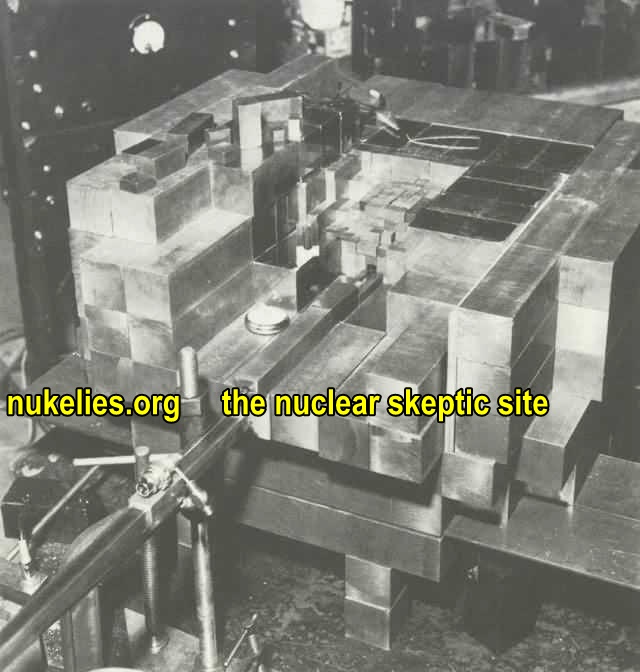Dr. Louis Slotin
What is tickling the Dragon's tail?
Question:
By the way, what would be the exact quantity of enriched Uranium 239 needed to produce a continuous chain reaction with minimal initiation energy?
Answer:
(from Science Education Partnerships)
My guess is that about 8KG of Uranium would be about enough. (Note from Larry Lavitt: DO NOT) Try this experiment: Get a number of blocks of Uranium, in different sizes. Start with about 1KG pieces, and up to about 5KG in 1KG increments. Don't put them all in the same box.
Take two of the smaller pieces, and record their masses. Then carefully push the two blocks together. If nothing interesting happens, it isn't big enough. Record that fact. When something interesting does happen, you will (briefly) know the mass needed for a chain reaction.
Note: In the old days, they did this in deserted canyons and called it "tickling the dragon's tail". There aren't many deserted canyons nearby, but most anyplace in California will do.
Actually, this is exactly how atomic physics operated during the cowboy stage of World War II in the Manhattan Project to build the Atom Bomb.
They didn't have the powerful electronic calculators which came after the war, so they used women, who were called ... calculators.
And they determined the critical mass of the bombs by exactly the method you describe. It was called "tickling the tail of the dragon", and it was done with a couple of screwdrivers held in the bare hands, working on top of a bare metal lab table in a shed down in a canyon off the mesa at Los Alamos.
They pushed the hemispheres together till they were close enough to produce the beginning of a chain reaction, which they detected by the blue glow set up in the air around the hemispheres by Cerenkov radiation (ionisation of the air itself). Then they pushed the hemispheres apart with the screwdrivers.
While having the hemispheres meet would not have produced a true rapid chain reaction and nuclear explosion, it would have produced a meltdown and a chemical explosion from heat and spread huge amounts of radioactive debris.
After the war, as experimentation continued, it got to be quite a daring sport. At least two workers made mistakes, lost control of the screwdrivers, and died.
One, Louis Slotin, saved a roomful of colleagues from lethal radiation exposure when he slipped and the hemispheres met, by pusing them apart with his bare hands. He died -- nastily -- in about five days. All the others lived.
From: https://www.dandugan.com/waldorf/WCA%20A ... A9711.html (No longer available.)
Created: June 7, 1999
https://web.ncf.ca/lavitt/louisslotin/tickle.html

The test assembly for "tickling the dragon's tail", an experimental determination of the critical mass of the uranium bomb. A small uranium hydride slug was dropped through this almost critical assembly of slugs. For a fraction of a second, the assembly "went critical".
https://www.mphpa.org/classic/LA/Photo-P ... AP-217.htm
Excuse me, but isn't a 'fraction of a second' all it takes?